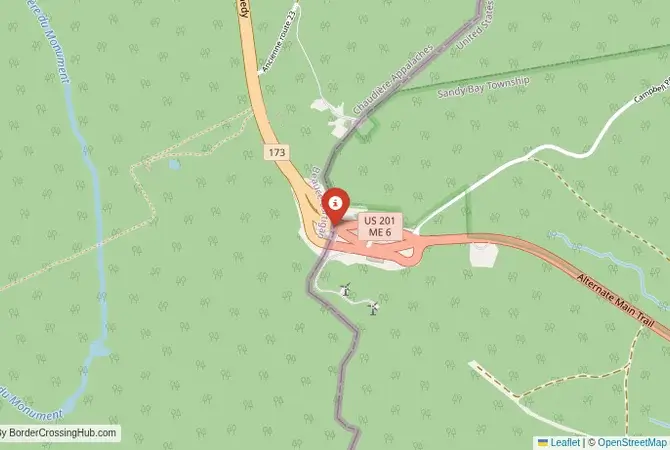
Approximate Border Location
Border Countries
- 🇺🇸United States
- 🇨🇦Canada
Border Cities
- 🇨🇦Armstrong, Quebec
- 🇺🇸Jackman, Maine
Wait Times
15-30 min for pedestrians/vehicles
Operating Hours
Open 8:00 AM – 6:00 PM
Crossing Types
Pedestrians, vehicles
Border Type
Land crossing via road
Peak Times
Mornings (7-10 AM)
Daily Crossings
~1000 travelers/vehicles
Currency Exchange
Limited near Jackman (USD, CAD)
Safety Information
Remote, beware weather
Languages Spoken
English
Accessibility Features
Ramps
About Armstrong, Quebec & Jackman, Maine
Warning
The Armstrong, QC – Jackman, ME border crossing, also known as Armstrong Border or Jackman Station, is remote with occasional scams; stay cautious, use official services, and verify details with government sources.
Tucked in Maine’s forested northwest, the Armstrong, QC – Jackman, ME border connects Quebec’s Beauce region with Maine’s Somerset County via Route 173. This serene crossing, surrounded by pine woods and rolling hills, offers a low-traffic route for travelers seeking Quebec’s rural landscapes or Maine’s outdoor adventures. Its isolation makes it a favorite for those craving a peaceful border experience, far from the hustle of larger crossings.
Before Crossing
Crossing borders gets messy sometimes, think political flare-ups or gates shutting fast. Good travel insurance is a must for handling doctor visits, trip disruptions, or security scares. Don’t get caught unprepared. To find a policy that’s got your back, check out reliable plans today for peace of mind.
Historical and Geopolitical Context
The border traces its roots to the 1842 Webster-Ashburton Treaty, which settled disputes between the U.S. and British Canada, defining Maine’s boundary with Quebec. Historically, it served loggers and traders moving timber and furs across the frontier. Today, it supports small-scale trade in maple syrup, lumber, and agricultural goods. In early 2025, Canadian customs tightened inspections due to smuggling concerns, leading to occasional delays, particularly for commercial vehicles. Checking border status before travel is wise, as regional tensions or inspections can impact operations. The crossing’s quiet nature reflects the close-knit ties between local communities, with many residents crossing regularly for work or family.
Crossing Procedures and Wait Times
Open 24/7, this border sees minimal traffic, with waits typically under 15 minutes, though summer tourism (July-August) can push delays to 30 minutes. You’ll process U.S. exit stamps at Jackman’s customs office on Route 201, then drive about 2 km to Armstrong’s Canadian immigration for entry. Most nationalities, like Europeans or Australians, receive a 90-day visa-free stamp for Canada; U.S. entry requires a passport or NEXUS card for non-residents. Carry your passport and, if driving, vehicle registration and proof of insurance. NEXUS lanes, for pre-approved travelers, may have reduced hours (often 8:00 AM to 8:00 PM), so confirm availability. English and French are spoken, but French dominates in Armstrong, so basic phrases help. Wait times are rarely posted online, but calling U.S. Customs (207-668-2231) provides updates.
Scam Awareness
Scams are uncommon due to the crossing’s low volume, but vigilance is key. Unofficial money changers in Jackman offer poor exchange rates; stick to ATMs or banks in Jackman or Saint-Théophile, 10 km north. Taxi drivers may inflate fares (~$20-30 USD) for short trips; always negotiate upfront. Avoid unofficial “border guides” offering paperwork assistance, as they’re unnecessary at this straightforward crossing. Some travelers report being approached by locals offering duty-free goods; verify legitimacy at Jackman’s duty-free shop before purchasing.
Transportation Options
No public buses serve this border directly, so you’ll rely on taxis (~$30 USD) or private cars, which take 10 minutes between Jackman and Armstrong via Route 201 and Highway 173. From Armstrong, buses from Saint-Théophile to Quebec City (2 hours, ~CAD 40) run infrequently, so check schedules at local stations. Roads are paved but narrow, winding through dense forests with occasional moose sightings, so drive cautiously. Pedestrians can cross, but town centers are 10-15 minutes away by car, making vehicles preferable. Winter road conditions can be treacherous, so check Maine’s 511 system or New Brunswick’s equivalent (800-561-4063). The scenic route offers glimpses of the Kennebec River and rural farmlands, adding charm to the journey.
Nearby Attractions and Tips
Jackman’s Moose River Valley is a haven for hiking, fishing, and snowmobiling, with trails like Number 5 Mountain offering stunning views. In Armstrong, nearby Saint-Théophile has small cafes serving poutine and maple treats, reflecting Quebec’s culinary culture. About 100 km north, Quebec City’s historic Old Town, a UNESCO World Heritage Site, is a must-visit for its cobblestone streets and Château Frontenac. Carry USD or CAD, as ATMs are scarce in Armstrong, and card payments may not be accepted at small businesses. Stay in Jackman for motels along Route 201 or campgrounds like Jackman Landing for a rustic experience. A Canadian SIM card ensures connectivity, as U.S. signals fade near the border. Book outdoor activities, like moose safaris or ATV tours, through reputable operators in Jackman to avoid overpriced deals.
Seasonal and Weather Considerations
Summer (June-August) brings warm weather (20-25°C) and increased tourism, slightly lengthening waits. Winter (December-March) delivers heavy snow (-10 to 5°C) and icy roads, requiring snow tires or chains; check conditions via 511 services. Spring and fall are quieter but rainy, so pack waterproof gear. Peak holiday weekends, like Canada Day or U.S. Labor Day, see minor congestion, so aim for early morning crossings to avoid delays.
Planning Your Crossing
Bring a valid passport or NEXUS card, vehicle documents, and cash for small transactions. Use official transport and avoid unofficial services. Check border status online or by phone for any closures or delays. This crossing offers a serene entry into Quebec’s rural heart or Maine’s wilderness, perfect for travelers seeking nature and tranquility over crowded routes.
No reviews yet.
